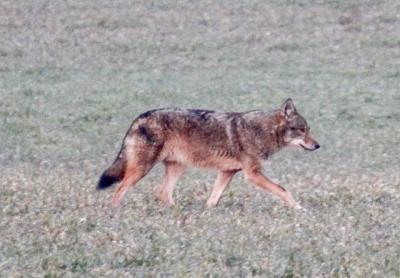Nature Notes: The Coyote Persists

Another coyote has been found on the South Fork, this one spotted and photographed by Chris Bustamante in a grassy opening north of County Road 39, between Majors Path and North Main Street in Southampton less than a week ago. Dell Cullum, one of the first to see and photograph a coyote several years ago in the Sagaponack area, thinks it might be the same one that appeared in Water Mill a few years later.
Scientists who have studied the Eastern coyote now call it a coywolf, as it also has some gray wolf genetic material. It is a hybrid that probably resulted from the eastward march of the coyotes in the mid-1900s meeting up with the few remaining native wolves at that time in Canada and northern Michigan. When I was a wildlife conservation student at Cornell University in the 1950s, students there from rural New York State would talk about the coydogs, apparent hybrids between coyotes and dogs.
Now we know from numerous studies of the creatures’ chromosomes and mitochondrial RNA that the coywolf is about 60 parts coyote, 30 parts wolf, and 10 parts dog. Wolves have apparently been interbreeding with dogs for thousands of years in the Old World, and now they are doing that with coyotes here in North America, probably because wolves have been slaughtered right and left since colonial times, and coyotes have increased their numbers greatly. It is now much easier for a horny wolf to find a willing female coyote than a purebred wolf. Thus the scientific name of the coydog has now become Canis latrans X Canis lupus. One could add “X Canis domesticus,” but scientific naming has yet to reach that level of sophistication.
In “The Mammals of Long Island, New York,” a definitive work on our mammals written in 1971 by Paul Connor of the New York State Museum in Albany, the coyote is not mentioned, but gray wolves are, as they were not uncommon here in colonial times. It is even postulated that the local wolves had been inbreeding with Native American dogs a long time before European settlement.
An early act of the East Hampton Town Trustees forbade the letting loose of the Native American dogs because they could attack livestock pastured in Montauk and elsewhere in the town. Our gray wolves completely disappeared long before, along with the native wildcats, beavers, and black bears.
The existence of the last species on Long Island before settlement remains to be determined. The only evidence that Ursus americanus might have been on Long Island in the past are the teeth, bones, and claws recovered from Native American archaeological sites here.
The question raised by this latest observation is: Are these three sightings one and the same animal? We know that other coywolves occur here and there on Long Island. They have been seen in Nassau County and Queens. We know that there are a few in the Bronx, or at least they have been spotted there in the past. Will the local coywolf or coywolves find a mate or mates? Will they eventually prosper?
If they do multiply they will be competing for food with red foxes, raccoons, feral cats, and a few other here-and-there carnivores? Might they not keep the deer populations in check? The literature tells us that the coywolf is larger than a Western coyote, but smaller than a gray wolf. Several adult red foxes have been seen in the last couple of weeks, including one seen by me during a firefly expedition in Amagansett. But we know that the foxes have had a very tough time increasing their numbers after two very severe visitations by the mange in the years since 1985.
Then, too, there are those among us who would opt to suppress the coywolf population the way they have tried to suppress the white-tailed deer, the only large land mammal that has survived on Long Island for thousands of years. Indeed, the white-tail deer was here before the first Native Americans came ashore.
And then there’s this question: Is Wile E. Coyote a real coyote or just another impostor coywolf? Dell Cullum is trying to keep track of our coywolf or coywolves. If you see one you might call him. He’s in the phone book.
